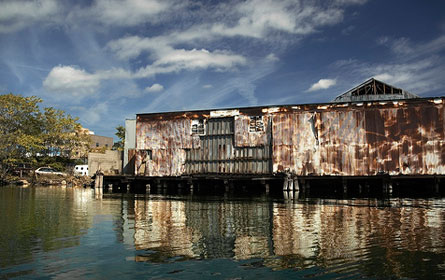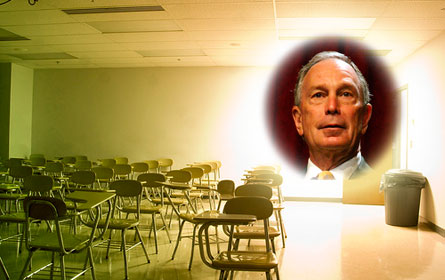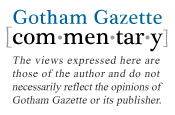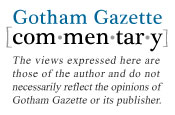Brooklyn's Lavender Lake Needs Superfund

After almost 150 years of industrial use and decades of raw sewage discharges from New York City's combined sewer system, the Gowanus Canal has become one of the nation's most contaminated bodies of water. The putrid sediments at the bottom of the canal contain PCBs, heavy metals, pesticides, volatile organic compounds, sewage solids and coal tar wastes. Adding to this toxic legacy, the manufactured gas plants, cement factories, oil refineries, tanneries, chemical plants and other industries that have called the canal home also have left behind underground plumes of pollution and contaminated the land and the groundwater, which continues to leach toxins into the canal.
On April 8, 2009, the federal Environmental Protection Agency announced a proposal to include the Gowanus Canal in the federal Superfund Program, which cleans up hazardous sites. This followed a request from the New York State Department of Environmental Conservation, which acknowledged that cleaning up the Gowanus would be too complicated for the state to handle. Soon after the Environmental Protection Agency's announcement, Mayor Michael Bloomberg announced his opposition to the agency's proposal, saying the city could handle the job.
(For an opposing viewpoint on cleanup of the Gowanus Canal, see On the Gowanus, Say 'No' to Superfund.)
How Superfund Works
The federal Superfund program was created in 1980 in response to public outrage over the threat that toxic waste sites such as Love Canal and Valley of the Drums posed to human health and the environment. Superfund provides the EPA with authority to respond to releases of hazardous substances that may endanger public health or the environment and to clean up many of the country's most contaminated sites.
About 70 percent of site cleanups are paid for by parties thought to be responsible for the pollution. EPA has power under Superfund to force the responsible parties to clean up a site or risk penalties, including having to pay EPA three times the cost of any remediation financed by the trust. However, if the responsible party cannot be found or has gone bankrupt, the Superfund trust can pay for the remediation of highly contaminated sites. Once a site is listed on a National Priorities List, the EPA can use money from the fund to fully investigate the extent of contamination, perform a remediation feasibility study and work on the site. Unfortunately, the Superfund trust is no longer funded by taxes on polluting industries and now relies on $1.2 billion in yearly congressional funding.
A Comprehensive Cleanup
After decades of environmental abuse, the Gowanus Canal is poised to leave behind its history as the "lavender lake," so called because of the color industrial waste tinged its waters, and be redeveloped into a community offering, housing, retail and recreational opportunities. With input from many active community organizations, the current redevelopment proposals envision neighborhoods focused on a clean canal with parks, a public promenade, and increased access to and use of the water.
With this future as a backdrop, the Gowanus Canal must be cleaned up in a comprehensive and thorough manner. Various individual plans address some of the environmental problems in the canal and surrounding area, but none of these proposals deals with the contamination in the canal itself or seeks a comprehensive solution to the continued leaching of pollutants from contaminated sites into the canal.
Several sites in the area are in the process of being cleaned up under state Department of Environmental Conservation supervision, including the future Whole Foods site at Third Street and Third Avenue, the Toll Brothers site on Bond Street, and the Public Place site at Fifth and Smith streets. The city also has plans to reduce the volume of combined sewer overflows that enter the canal and to rehabilitate the flushing tunnel that pushes cleaner water into the canal from New York Harbor.
If the Gowanus Canal is listed on Superfund's National Priority List, these projects will continue under state supervision as planned. However, the EPA has stated that the most important task of any cleanup would be to stop the upland leaching of pollution into the canal. In addition, according to the agency, existing clean-up projects must be coordinated with the remediation plan for the canal. This coordination may delay some development projects.
The ultimate goal must be a comprehensive and thorough cleanup of the canal, rather than a piecemeal approach by state and city agencies with different priorities. While not a perfect solution, a Superfund designation will provide the best chance for a thorough cleanup of the canal, so that this unique waterway can serve as the centerpiece of a revitalized neighborhood where residents can enjoy the canal itself and the surrounding land, free of concerns over the public health threat of any toxic pollutants lurking beneath the surface.
The Lowe's Home Improvement store on Second Avenue serves as an example of the dangers associated with cleaning up contaminated land without comprehensive planning. The Lowe's was built on the site of a former manufactured gas plant and was remediated under the State Brownfields Program. Although Lowe's conducted a cleanup prior to starting construction, published reports state that Lowe's did not address the entire site and that coal tar contamination has now migrated toward the supermarket next door. Without a comprehensive cleanup plan for the canal there is a danger that other sites will not be adequately remediated, leading to the continued pollution of land, groundwater and the canal.
The City's Plan
When Bloomberg announced his opposition to listing the canal as a Superfund site, he indicated that the city would come up with an alternative plan that would achieve virtually the same goal, but without the perceived stigma that "Superfund" carries. The administration has not released final details but promises that its alternative will be supervised by the EPA, will study the canal's contamination to the same extent that Superfund would and will achieve a cleanup to the same standards. The city has also proposed having the parties responsible for the contamination pay for a portion of the cleanup and is seeking funding for dredging of the canal from the U.S. Army Corps of Engineers.
With a price tag for the cleanup that could reach $300 million to $400 million, it remains uncertain whether responsible parties would pick up part of the costs and whether money from the Army Corps would provide sufficient funding. Any cleanup that does not list the canal on the National Priority List would not allow the EPA or anyone else to use money from the Superfund trust to study the extent of contamination, pay for cleanup if necessary or compel the original polluters to do the cleanup themselves.
Although the city has provided few specifics about its proposal, any alternative to Superfund would lose the tools and funding of the Superfund program, while gaining few if any advantages. This is why Superfund presents the best mechanism for retiring the Gowanus Canal's "lavender lake" stigma once and for all.
Joshua S. Verleun is a staff attorney at Riverkeeper, Inc.
The Great School Debate

With the law establishing mayoral control of the New York City school system set to expire at the end of June, parents, educators and other concerned New Yorkers have widely varying opinions over the successes and failures of the current system and whether it should remain as is, be tweaked or totally rehauled. On May 11, Citizens Union Foundation, Gotham Gazette's publisher, along with the Baruch College School of Public Affairs, held a forum on the issue.
Moderated by Doug Muzzio, professor of public affairs at Baruch, it featured:
Ana Maria Archila, co-executive director, Make the Road NY
Rev. David Brawley, co-chair, East Brooklyn Congregations
Joel Klein, chancellor, New York City Department of Education
Monica Major, president, Community Education Council, District 11
Michael Mulgrew, chief operating officer, United Federation of Teachers
Joseph Viteritti, former executive director, Commission on School Governance
The following are edited comments excerpted from their discussion.
Who's In Charge?
"To me, the most essential feature of mayoral control is that the mayor chooses a majority of members of the school board. ... In a few places where they call it mayoral control, I wouldn't call it mayoral control. For example in Oakland, the mayor picks three members of a 10-person board. I don't think that's control. In Baltimore, mayors share that with the governor. I don't think that's control." -- Joseph Viteritti
"The question of governance is fundamentally whether the mayor will have the same authority over the school system that he or she has over safety, over health, over finances. The present structure is sound and I worry that, as we try to improve the system, we undermine it and create divided authority. The mayor has to be able to support a majority of the members [of the Panel for Education Policy] and they serve at his pleasure. No terms." -- Joel Klein
"The form of mayoral control we have in New York is the most extreme. You don't have a space for parents and students and stakeholders to participate in the debate." --Ana Marie Archila
"It's not a burden for a chancellor to have to make a persuasive case [to a board with a majority of mayoral appointees]. That's an opportunity to make your case." -- Viteritti
"We're New Yorkers. We like to debate. That's' what we do. In our proposal, we have 14 members on the [Panel on Educational Policy]. Every policy should have some debate. The mayor would only have to swing two votes. If there is an issue, isn't it better as a city if we have some debate?" -- Michael Mulgrew
"I am old enough to remember Mayor Giuliani and young enough to know I'll have kids in school when there will be mayors I don't like." --Archila
"We have got to be bold. A mayor may or may not be bold, but if he or she doesn't have the authority, thee is going to be special interest capture." -- Klein
The Bottom Line
"It's a not a question of how we hold the mayor accountable. The discussion should be how do we insure students who historically have fallen through the cracks do not continue to fall through the cracks." -- Archila
"If we had this debate under the old system there would be no room because everyone who made a paychecks on the backs of our children would want to be here." -- David Brawley
"Not a single person on the panel has said we want to go back to the old system. We want to move forward. Everyone here has the best interests of the children at heart. We are all trying to do the best thing for out children and the city as a whole." -- Mulgrew
A Place for Parents
"We need to make sure our public institutions can hear the public." -- Archila
"One of the things that the old board did well -- and there weren't many of them --- was force a public conversation." --Viteritti
"Parents come out to complain, and they're frustrated, Some don't have the resources to properly advocate for their children." -- Monica Major
"When you have parents, teachers and students working together, then you have a successful school. [At the hearings the UFT held,] parents in every neighborhoods no matter what the demographics said 'we feel shut out of the system'." -- Mulgrew
"People think trying to participate in the current system is not a good use of their time." -- Viteritti
"In the old days, you had the debate but no results." -- Brawley
"We're the only system that does a parent poll. A few people claim they speak to parents. I like to listen to all of them." -- Klein
We should make sure that when parents organize, they're not treated as a special interest." -- Archila
"I don't think parents are a special interest, but people kid themselves when they say they speak for parents." -- Klein
Looking at the Numbers
"This is the Mark Twain, lies, damns lies and statistics part of the program." -- Mulgrew
"To use [test scores] to evaluate a governance system is not a good idea." -- Viteritti
"In East New York, the percentage of student passing the state reading tests is up by 16 points. One reason that is happening is the chancellor is willing to make hard decisions." --Brawley
"Our students are closing in on the rest of the state. After a decade of stagnation in this city, we are making real change." -- Klein
"These grades [on the school report cards] do not match what is going on in the city. They are based on a metric you can't explain to parents." -- Major
An Outside Eye
"[Oversight by the Independent Budget Office is needed] to make sure we all have information about performance and to make sure the money goes where it really needs to go." -- Archila
"I'm confident about the data...and I'm happy to have an outside body investigate." -- Klein
To Tweak or to Tinker?
"Mayoral control creates a capacity for change that didn't exist before. I support a strong system of mayoral control, but it can also have checks and balances." -- Viteritti
"I hope the system remains as it is. Tweaking is one thing. Tinkering is another." -- Brawley
"What we hope happens is that New York City has a better system because it can always be better, We are talking about Albany here, so it would leave it up to anyone to tell me what is going to happen." -- Mulgrew
"The state legislature is trying to figure it out. I hope their debate is as robust as our conversation." -- Archila
"This is as robust a debate as can possibly happen." -- Klein
In Charge and Unaccountable
I am a grassroots kind of guy. I believe that the best systems of governance welcome the participation of stakeholders. Good governance is open, and has debate and dialogue, clear lines of accountability and reasonable grievance procedures for resolving differences. Mayoral control of the city's public schools has not achieved these basic goals.
Additionally, because the chancellor is answerable only to the mayor, the children of New York City have, in some ways, lost their strongest advocate. No longer independent of the mayor's budgetary priorities, the chancellor's willingness to fight for school funding has been compromised by the ability of the mayor to hire and fire the chancellor and by the mayor's relationship with the governor and state Legislature.
Arguably, the best features of mayoral control should be on the business side (the Department of Education has the largest budget of any city department at more than $18 billion). In fact in several cities that have adopted mayoral control, the impetus was financial accountability. We should see efficiencies in procurement and operations. What I am seeing from my dual perspective as chairman of the New York City Council's Education Committee and as the lead plaintiff in the Campaign for Fiscal Equity lawsuit, which stimulated the recent influx of education funding, is a distressing mix of privatization of basic functions and no-bid contracts.
For example, two and a half years ago I chaired a council hearing that explored a number of no bid contracts entered into by the Department of Education. We looked hard at the $15.8 million contract that went to Alvarez & Marsal, a global consulting firm based in New York City, to find cost savings through restructuring. That firm's recommendations on school transportation were implemented in the dead of winter in the coldest weather we'd had in a long while, leaving kids standing outdoors in below freezing temperatures while the kinks in the new plan were worked out. Some of my constituents complained, and rightly so, about glaring errors like student pick-up times scheduled after the start of the school day. It was an outrage.
And what were the long-term savings brought by this no bid contract? It's very hard to say because of the lack of transparency in the department's budget. I can only tell you that the department's transportation budget went up $52.5 million between fiscal year 2008 and the current fiscal year.
The City Council looked hard at that contract, but there was little we could do. Since education law is STATE law, the Department of Education always says that it is accountable only to the state. Quite frankly, I don't think the Assembly members and senators from upstate counties should really be that involved -- at the detail level -- in the oversight of the New York City schools. City residents are the stakeholders here, and city government is where oversight, compliance and enforcement should rest.
Accountable to No One
In 2005 the City Council passed legislation that required the education department to submit an annual report on the number of substandard or temporary classrooms and the number of students in them. After initial compliance, we received a letter saying that the department would not provide the data.
The Department of Education does not comply with state mandates either. Classes are not supposed to be held in rooms without windows. Yet 18 percent of principals responding to a recent survey (you can view the responses here) indicated that one or more classrooms in their schools were windowless. And this was no small sample – these principals represent 41 percent of the city's student body. Physical education instruction is provided for less than one hour per week in 47 percent of the responding schools. Our schools are not up to state mandated instructional standards in art, science or health either. When I asked the Department of Education how many classes received health instruction from uncertified teachers, it could not answer even though there were only 200 certified instructors for this subject in the entire system. But no sanctions or reprimands are issued when the department fails to meet the state standards.
Sometimes this failure is colossal. As the council readies to vote on the Department of Education's new $11.3 billion capital plan, it is worth pondering how our current governance structure deals with the department's refusal to meet state standards.
Contracting Excellence
Back in 1991, when Michael Rebell and I started the Campaign for Fiscal Equity, overcrowded schools and large classes were characteristic of New York City, particularly in Community School District 6 where I was the school board president. I now represent parts of the same area in the City Council.
Fifteen years later, the lawsuit at last produced something tangible: the Contract for Excellence. In this historic agreement the state requires that the city's five-year capital plans be aligned with the standards specified in the Contract for Excellence.
But currently, the five-year capital plan is not aligned with the Contract for Excellence Standards. For example, the Contract for Excellence agreement calls for classes of 23 students in middle schools and high schools; the capital plan provides for classes of 28 as its benchmark for upper elementary and middle schools and sets 30 as the high school cap, falling far short of the contract standard and way below the recommendations put forth by the Campaign for Fiscal Equity. The department consistently puts two teachers in one classroom and calls it "class size reduction."
Now, I have what I consider to be a sound, basic education. I didn't go to Harvard, and I don't have a graduate degree, but I am educated enough to know that "reducing teacher-student ratio through team teaching strategies" is NOT the same thing as reducing class size.
When the Council is asked to approve a plan that violates state law, we are between a rock and a hard place: a NO vote stops all capital work; a YES vote approves a plan that violates state law. Clearly this is not only an inadequate capital plan, but an inadequate governance structure that encourages the Council to be a rubber stamp for mayoral failure to adhere to state law. But how many council members have the political will to completely stop all school repairs and construction in order to force the mayor to comply with state law?
Governance should not be dependent on the popularity or personality of an individual office holder. The quality of governance should not be judged solely by the test results or graduation rates it produces (and there is some evidence that these numbers are suspect). It needs to be a system that also produces excellent, motivated teachers and supervisors; a system that produces engaged students; it must endure changes in demographics and weather dips in the economy -- what's going to happen to all the basics that are being funded by private contributions now? And most importantly, it must answer to the constituents it serves and not the single vision or political fortunes of the mayor of the city of New York.
I urge the state to move toward a governance system that rests on the broadest possible base with the greatest degree of accountability, transparency and community involvement.

Councilmember Robert Jackson has represented the neighborhoods of West Harlem; parts of Washington Heights, Inwood, Central Harlem and Morningside Heights since 2002. He is the chair of the council's Education Committee and co-founder of the Campaign for Fiscal Equity. He is also the parent of three daughters, all of who attended PS/IS 187 in Community School District 6, where he served on the Community School Board for fifteen years.







